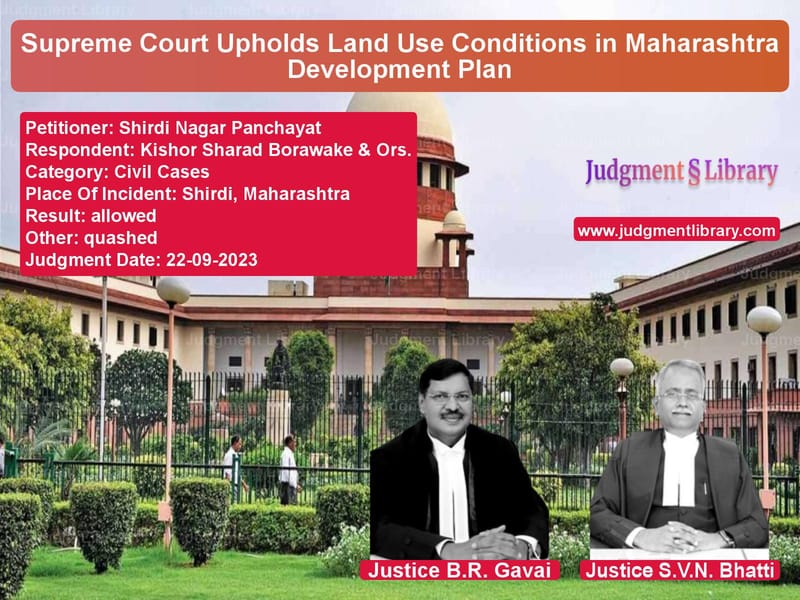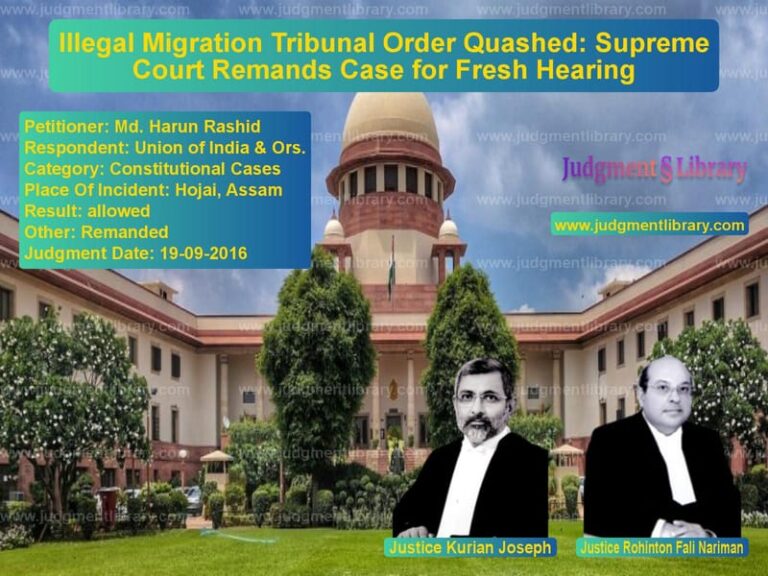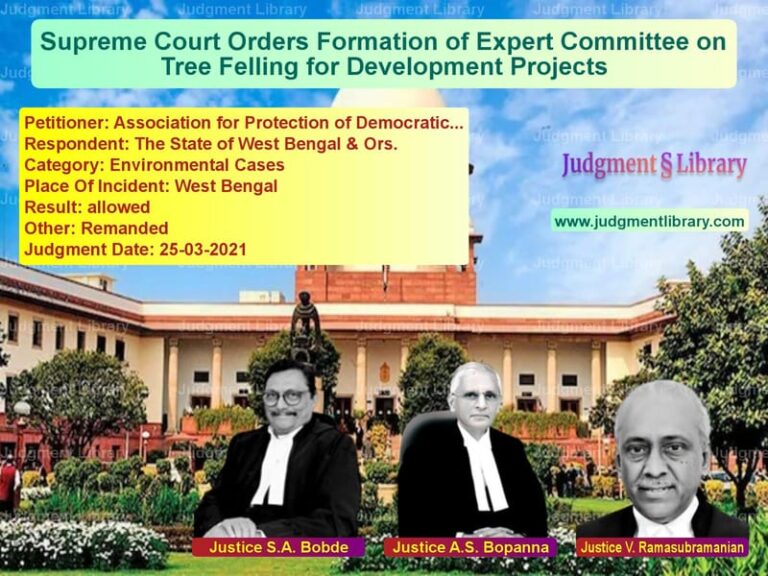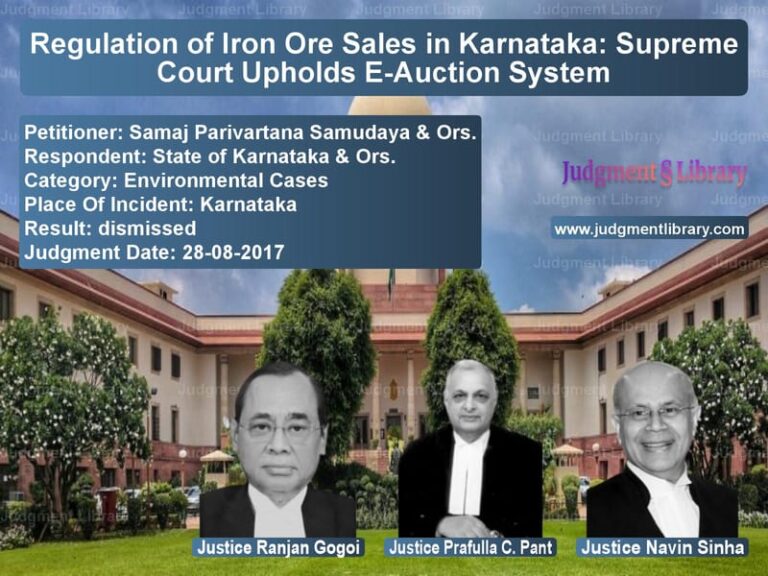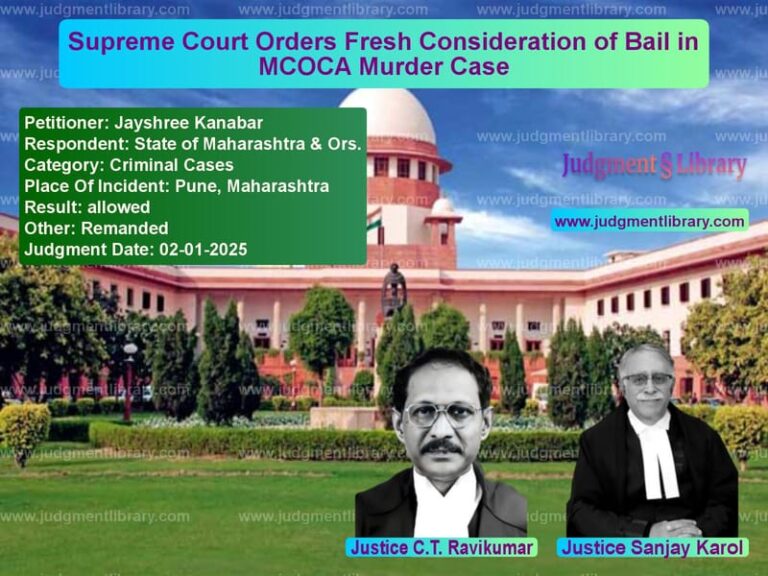Supreme Court Upholds Land Use Conditions in Maharashtra Development Plan
The Supreme Court of India has ruled in favor of Shirdi Nagar Panchayat in a dispute concerning the conversion of land from a ‘No Development Zone’ to a ‘Residential Zone’ under the Maharashtra Regional and Town Planning Act, 1966. The Court upheld the conditions imposed in the government notification requiring landowners to surrender ‘open space’ and ‘amenity space’ to the Municipal Council free of cost in return for development permissions.
Background of the Case
The case arose from a government notification dated 18 August 2004, which converted certain lands from a ‘No Development Zone’ (Green Zone) to a ‘Residential Zone’ (Yellow Zone), subject to the landowners transferring:
- 10% of the land as ‘open space’
- 10% of the land as ‘amenity space’
- Additional land for roads
The land in dispute, located in Shirdi, Maharashtra, was originally categorized as a Green Zone in the Development Plan published on 15 December 1992. The landowners sought and received development permission based on the 2004 notification and executed agreements with the Shirdi Nagar Panchayat, handing over the designated ‘open space’ and ‘amenity space’.
Read also: https://judgmentlibrary.com/supreme-court-upholds-validity-of-will-in-family-property-dispute/
However, years later, the landowners and plot holders challenged the surrender conditions, claiming that the land should remain with them rather than be transferred to the Municipal Council.
Legal Issues Raised
The case involved the following key legal issues:
- Whether the government’s condition requiring the surrender of ‘amenity space’ was legal.
- Whether landowners, after benefiting from the conversion, could later challenge the conditions.
- Whether the Municipal Council had the right to develop the ‘amenity space’ for public use.
Petitioner’s Arguments (Shirdi Nagar Panchayat)
The Municipal Council, represented by Senior Counsel Sanjay Kharde, argued:
- The landowners had willingly accepted the conditions in 2004 and executed agreements transferring ‘amenity space’ and ‘open space’.
- The landowners subsequently developed and sold plots to individual buyers based on the sanctioned layout, which clearly earmarked land for the Municipal Council.
- The landowners had also sought an injunction in civil court, but after losing, they attempted to use writ petitions as an alternative.
- The plot holders knowingly purchased land with the development plan clearly showing designated ‘open space’ and ‘amenity space’.
Respondents’ Arguments (Landowners and Plot Holders)
The landowners and plot holders, represented by Amol Gavali and Pradnya Talekar, contended:
- The Municipal Council could not force them to surrender their land without compensation.
- Under the Development Control Regulations (DCR), ‘open space’ should belong to the plot holders, not the Municipal Council.
- The Municipal Council’s plan to construct a swimming pool and indoor sports complex on the ‘amenity space’ was not part of the approved development plan.
- They relied on Pt. Chet Ram Vashist vs. Municipal Corporation of Delhi (1995), where the Supreme Court held that municipalities cannot demand land free of cost.
Supreme Court’s Observations
A bench comprising Justices B.R. Gavai and S.V.N. Bhatti ruled in favor of Shirdi Nagar Panchayat. The Court made the following key observations:
1. Doctrine of Election Applies
The Court held that the landowners had willingly accepted the conditions for land conversion and executed agreements transferring ‘amenity space’ and ‘open space’. Since they benefited from the government notification, they could not now challenge it.
“A party cannot take advantage of a government policy, sell land based on it, and then challenge the very policy after gaining benefit from it.”
2. Delay of 14 Years in Filing Petition
The landowners challenged the 2004 notification in 2018, after nearly 14 years. The Court ruled that the delay itself was a strong ground for dismissal:
“The petition suffers from gross delay and laches. The landowners acted upon the notification, obtained development permissions, and sold plots, and only after all these benefits were availed did they challenge the notification.”
3. Plot Holders Had Knowledge of Development Plan
The Court rejected the claims of plot holders, ruling that they were aware of the designated ‘open space’ and ‘amenity space’ when purchasing their plots:
“Purchasers cannot claim ignorance when the sanctioned layout clearly demarcated 10% of the land as ‘amenity space’ and 10% as ‘open space’ for public use.”
4. Distinction Between ‘Open Space’ and ‘Amenity Space’
The Court ruled that while ‘open space’ remains for common use of plot holders, ‘amenity space’ rightfully belongs to the Municipal Council. It distinguished the present case from Pt. Chet Ram Vashist (1995), stating:
“In Chet Ram Vashist, the land in question was compulsorily reserved under development regulations. Here, the ‘amenity space’ transfer was a condition for changing land use, which the landowners accepted.”
5. Public Utility Requirement Justified
The Court upheld the Municipal Council’s plan to develop public facilities on the ‘amenity space’:
“If the government grants land conversion benefits with a condition of transferring land for public amenities, such conditions are enforceable.”
Final Verdict
The Supreme Court ruled:
- The Bombay High Court’s judgment dated 4 July 2019 was set aside.
- The landowners and plot holders’ challenge to the 2004 notification was dismissed.
- The ‘amenity space’ rightfully belongs to the Municipal Council and cannot be reclaimed.
- The Municipal Council is free to develop the ‘amenity space’ for public welfare.
- The plot holders may file a representation if they seek alternative arrangements for preserving old trees on the land.
Implications of the Judgment
This ruling has significant implications for land use regulations and municipal development policies:
- Prevents Abuse of Government Policies: Landowners cannot benefit from development permissions and later challenge the terms.
- Clarifies Ownership of ‘Amenity Space’: Land designated as ‘amenity space’ in development plans vests in municipal authorities.
- Ensures Accountability in Urban Planning: Municipalities can enforce development conditions without legal reversals.
- Limits Unjustified Challenges: Courts will dismiss challenges filed after prolonged delays.
Conclusion
The Supreme Court’s ruling in Shirdi Nagar Panchayat vs. Kishor Sharad Borawake & Ors. is a landmark decision affirming the enforceability of land-use conditions in urban planning. By upholding the Municipal Council’s right over the ‘amenity space’, the Court ensures that land development benefits the larger public rather than individual interests.
Petitioner Name: Shirdi Nagar Panchayat.Respondent Name: Kishor Sharad Borawake & Ors..Judgment By: Justice B.R. Gavai, Justice S.V.N. Bhatti.Place Of Incident: Shirdi, Maharashtra.Judgment Date: 22-09-2023.
Don’t miss out on the full details! Download the complete judgment in PDF format below and gain valuable insights instantly!
Download Judgment: shirdi-nagar-panchay-vs-kishor-sharad-borawa-supreme-court-of-india-judgment-dated-22-09-2023.pdf
Directly Download Judgment: Directly download this Judgment
See all petitions in Property Disputes
See all petitions in Landlord-Tenant Disputes
See all petitions in Specific Performance
See all petitions in Judgment by B R Gavai
See all petitions in Judgment by S.V.N. Bhatti
See all petitions in allowed
See all petitions in Quashed
See all petitions in supreme court of India judgments September 2023
See all petitions in 2023 judgments
See all posts in Civil Cases Category
See all allowed petitions in Civil Cases Category
See all Dismissed petitions in Civil Cases Category
See all partially allowed petitions in Civil Cases Category

